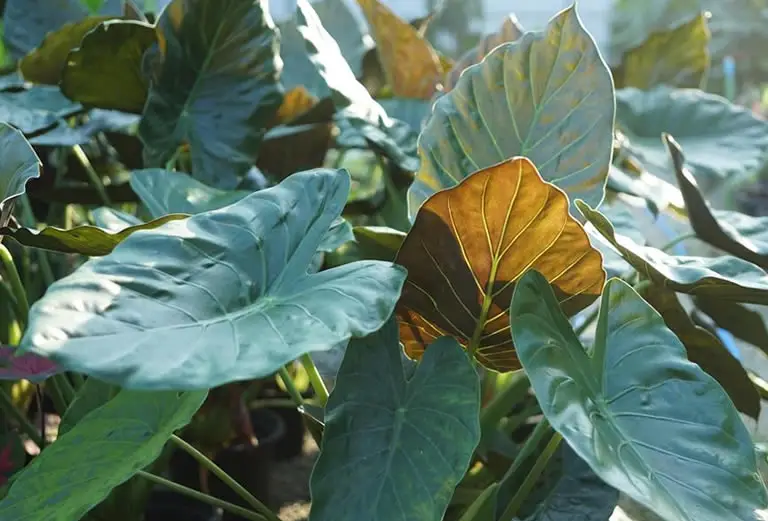Alocasia wentii, often called the “Purple Umbrella” or “New Guinea Shield,” brings serious tropical vibes to any plant collection. With glossy green leaves and deep maroon undersides, it’s a true showstopper. And while it’s considered one of the easier Alocasias to grow, this isn’t exactly a beginner’s plant.
In this guide, we’ll walk through exactly what your Alocasia wentii needs to grow healthy, lush, and strong—from light and watering to dormancy, pests, and propagation.
Table of Contents
- Meet the Plant: A Quick Look at Alocasia Wentii
- Light Needs: Bright Indirect Light Is Best
- Watering Routine: Keep Soil Lightly Moist (But Never Soggy)
- Soil Preferences: Choose a Well-Draining Aroid Mix
- Humidity Levels: Keep It High to Prevent Leaf Problems
- Temperature Range: Warm and Stable Is Key
- Feeding Needs: Monthly Fertilizer for Strong Growth
- Flowering: Not the Star of the Show
- Pruning Tips: Keep It Tidy and Healthy
- Repotting Advice: Only Repot When It’s Truly Rootbound
- Propagation: Divide During Spring Repotting
- Toxicity Warning: Keep Out of Reach of Pets and Children
- Watch for Pests: Spider Mites and Thrips Are the Main Threats
- Common Diseases: Prevent Fungal Problems with Proper Watering
- Dormancy: Don’t Panic If It Drops Its Leaves
- Troubleshooting: What to Do When Things Go Wrong
- Final Thoughts: A Rewarding Challenge for Tropical Plant Lovers
Meet the Plant: A Quick Look at Alocasia Wentii
Native to New Guinea, Alocasia wentii is a striking hybrid believed to come from Alocasia odora and Alocasia gageana.
It grows up to three feet tall and wide, with broad, slightly rippled leaves and a bold contrast between green tops and purple bottoms.
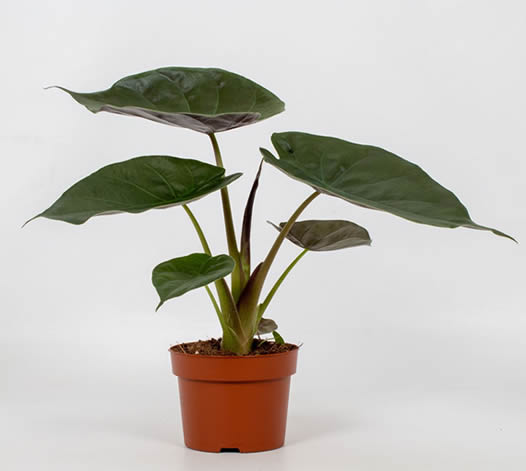
Outdoors in warm climates, it can be a landscape star; indoors, it shines as a sculptural centerpiece.
Light Needs: Bright Indirect Light Is Best
Alocasia wentii loves bright, indirect light. Think jungle canopy—not harsh rays.
A few hours of soft morning or late afternoon sun are usually fine, but too much direct light can cause leaf scorch.
Indoors, a foot or two back from a sunny window is ideal.
If natural light is limited, especially in winter, consider using a grow light to help maintain its vibrant foliage and prevent dormancy.
Watering Routine: Keep Soil Lightly Moist (But Never Soggy)
Alocasia wentii is a thirsty plant, but it’s also sensitive to overwatering.
The key is balance.
Let the top 1–2 inches of soil dry out before watering again, and always allow excess water to drain completely.
Tips for watering success:
-
Never let the soil dry out completely
-
Avoid watering near the plant’s fleshy stem (this area is prone to rot)
-
Flush the soil occasionally to remove salt buildup from fertilizers
Outdoors, especially in hot weather, you may need to water more frequently.
Indoors, your plant will drink less.
Soil Preferences: Choose a Well-Draining Aroid Mix
This plant thrives in a structured, airy soil mix that retains some moisture but drains well.
Without the right soil, watering becomes tricky—and root rot becomes a real risk.
Recommended soil mixes:
-
A pre-made aroid blend with coco coir, bark, perlite, charcoal, and worm castings
-
DIY mix: 50% potting mix + 50% cactus mix
-
Add-ins like compost or worm castings boost nutrients but may increase water retention—use sparingly
Avoid compact, moisture-retaining soils that can suffocate the roots.
Humidity Levels: Keep It High to Prevent Leaf Problems
Coming from the tropics, Alocasia wentii thrives in humidity levels above 60%.
While it can survive in lower humidity (down to 40% in some cases), it may suffer from crispy tips and dull leaves.
Boost humidity with:
-
Pebble trays
-
Room humidifiers
-
Grouping plants together
-
Moving your plant to a naturally humid room like a bathroom or kitchen
More humidity usually means healthier leaves and better tolerance for light.
Temperature Range: Warm and Stable Is Key
Alocasia wentii enjoys temperatures between 55–86°F (13–30°C).
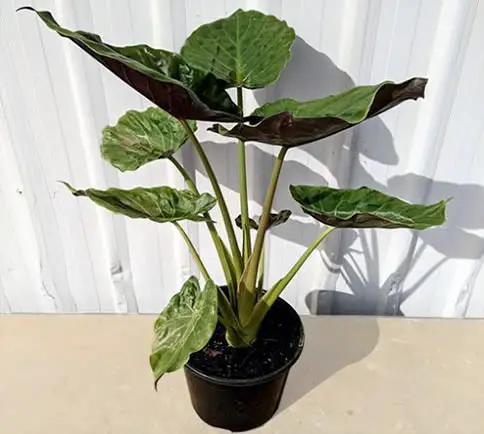
It will go dormant if temperatures drop too low and may struggle in extreme heat above 95°F (35°C).
During warmer months, you can move it outside—but bring it back indoors before temperatures fall in autumn.
Avoid placing it near drafts, radiators, or AC vents.
Feeding Needs: Monthly Fertilizer for Strong Growth
This plant grows quickly in the right conditions and is a bit of a heavy feeder.
Feed monthly during the growing season (spring and summer) with a balanced, diluted fertilizer at half strength.
Fertilizer tips:
-
Use organic options like worm tea or fish emulsion for gentler feeding
-
Avoid fertilizing in winter when growth slows
-
Flush the soil regularly to avoid salt buildup
-
Apply granular fertilizer at least six inches from the base if used
Flowering: Not the Star of the Show
While it can bloom, Alocasia wentii’s pale spathes aren’t particularly impressive and only last a few days.
Many growers snip them off to help the plant focus on foliage.
Pruning Tips: Keep It Tidy and Healthy
Pruning isn’t about shaping—it’s more about health.
Trim away damaged, dead, or yellowing leaves to encourage fresh growth.
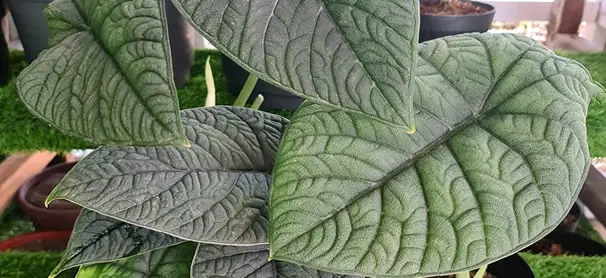
Always use sterilized tools, and be cautious around baby leaves emerging from the stem.
Each Alocasia leaf grows from the previous one, so avoid cutting both at once.
Repotting Advice: Only Repot When It’s Truly Rootbound
Alocasia wentii prefers a snug pot. It’ll grow just fine when slightly rootbound and doesn’t need frequent repotting.
Only repot when:
-
Roots are circling the pot
-
The soil dries out too quickly
-
The plant is top-heavy or stressed
Repot in spring, and go up only one pot size at a time. Avoid disturbing the roots too much to minimize shock.
Propagation: Divide During Spring Repotting
Alocasia wentii doesn’t root from cuttings, but it’s easy to propagate through division.
How to propagate:
-
Repot in spring and gently unearth the root system
-
Look for offsets, small clumps, or corms growing near the main rhizome
-
Separate with clean hands or a sterilized blade
-
Pot new divisions into small containers with aroid mix
-
Keep in a warm, bright area with high humidity until new growth appears
Water gently and avoid fertilizing until the new plants are established.
Toxicity Warning: Keep Out of Reach of Pets and Children
Alocasia wentii contains calcium oxalate crystals, which can cause irritation, vomiting, and swelling if ingested.
The sap may also cause skin irritation. Always wear gloves when handling, and keep it out of reach of curious hands and paws.
Watch for Pests: Spider Mites and Thrips Are the Main Threats
Keep a close eye on your Alocasia wentii—especially under the leaves—for signs of pests like spider mites and thrips.
These pests thrive in warm, dry conditions and can spread quickly.
If you see webbing or silver streaks:
-
Rinse the plant to remove bugs
-
Apply neem oil, insecticidal soap, or horticultural oil
-
Use diatomaceous earth for heavy infestations (apply dry and wear a mask)
Isolate infected plants from your collection and act quickly to prevent spreading.
Common Diseases: Prevent Fungal Problems with Proper Watering
Most diseases affecting Alocasia wentii are fungal and related to overwatering or poor airflow.
Brown or black spots on leaves are early signs.
To prevent disease:
-
Keep leaves dry
-
Avoid overwatering
-
Improve air circulation
-
Trim and discard heavily affected leaves
In severe cases, you may need to discard the plant to protect others.
Dormancy: Don’t Panic If It Drops Its Leaves
Alocasia wentii may go dormant if conditions change—especially after being moved indoors for winter.
Cooler temps and lower light can cause leaf drop, which looks dramatic but isn’t fatal.
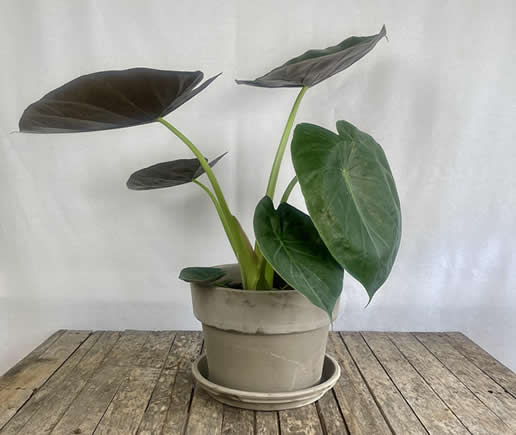
To prevent dormancy:
-
Maintain warm temps and bright light
-
Keep humidity high
-
Avoid letting soil dry out completely
If your plant goes fully dormant, reduce watering and wait for spring. It’ll regrow once conditions improve.
Troubleshooting: What to Do When Things Go Wrong
Yellow Leaves?
Often caused by overwatering or poor drainage. Check roots and adjust your watering routine.
Brown Leaf Tips or Edges?
Usually a humidity issue. Monitor with a hygrometer and raise levels as needed.
No New Growth?
The plant may be dormant or rootbound. Check for light, warmth, and proper soil conditions.
All Leaves Gone?
Don’t toss it! Dormant plants can regrow when the weather warms or lighting improves.

